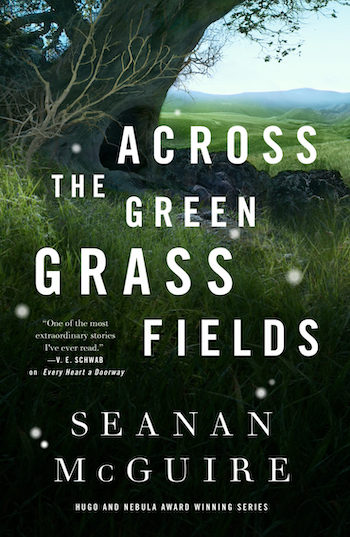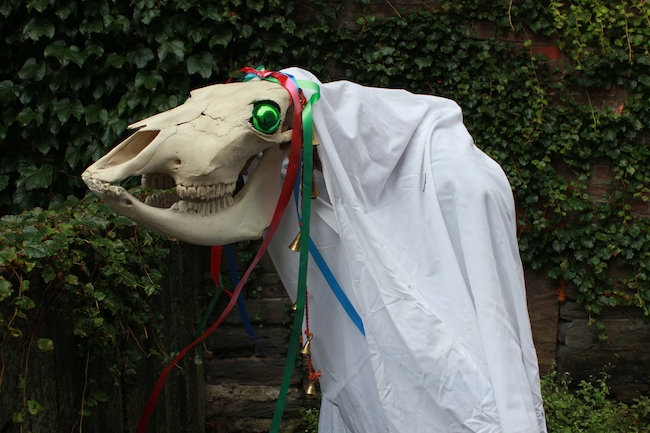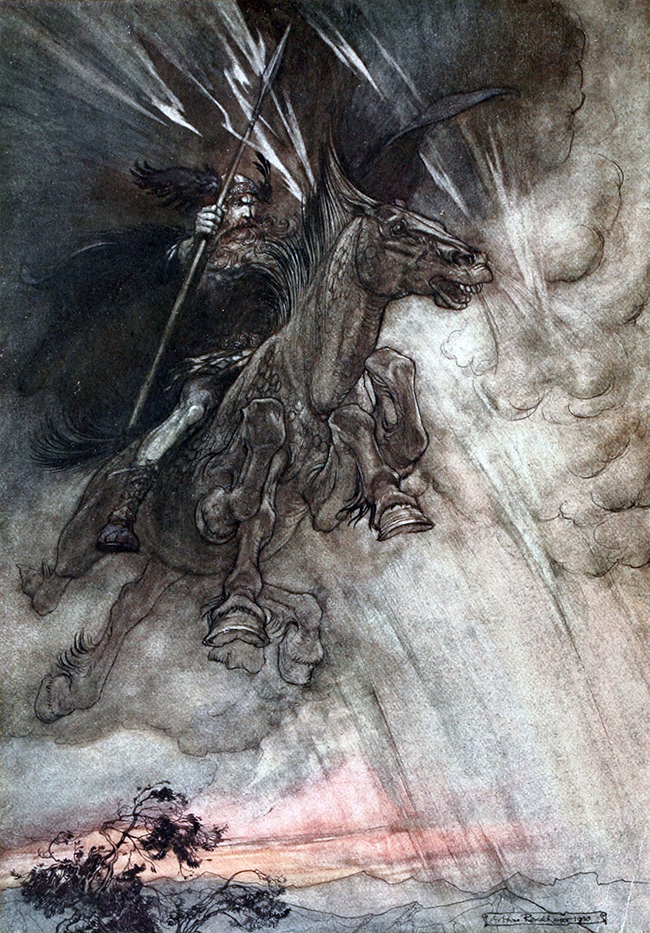When we last met Odin’s eight-legged horse Sleipnir, we focused on the practical aspects: how his parents got together, how his body might have been organized (or is it her? Or is it genderfluid?), what his superpowers were. But that’s not all there is to Sleipnir. Commenters were quick to point out the more mystical aspects of the All-Father’s mount.
One popular theory among academics and folkorists is that Sleipnir’s eight legs represent the legs of the pallbearers carrying the dead to the grave. Sleipnir had a direct connection with the dead and the otherworld in his ability to carry Odin through all the levels of existence including Hel.
I love the idea proposed by noblehunter and expanded by others that the extra legs were “shadow legs,” signifying Sleipnir’s ability to travel through air and water as well as over the earth, and by extension his ability to travel between worlds. From this perspective, the horse one would see in any given location would be a normal four-legged horse, but the secondary set of legs would exist in another continuum. The depictions of him with eight legs would be symbolic rather than literal. “This horse has superpowers,” rather than “This horse has eight actual legs.”
Either way, it’s no accident that Sleipnir is a grey. That’s a horse born dark, which turns white as it matures; it’s a genetic mutation, and it appears to descend from a single ancestor. Human breeders have cultivated it and woven myths around it.
Buy the Book


Across the Green Grass Fields
The white horse is the king’s horse, the shaman’s horse, the horse of heaven. Pegasus and the unicorn are white. Celtic Rhiannon rode a pale horse. Herodotus tells of the sacred white horses of Persia; white horses were (and are) revered in India, Korea, Viet Nam, the Philippines.
Most horses come in shades of brown or black. Some are spotted, but solid colors are much more common. A white horse stands out not only visually but for the relative rarity of the color.
There’s a ghostly quality to it, a luminosity, especially in low light. White horses glow in the moonlight, and shimmer even in starlight. Against the green and brown of its natural habitat, the steppe or tundra, the white horse is impossible to miss. There’s no hope of camouflage unless the horse coats itself in mud or dust.
Of course, being horses, greys will joyfully do exactly that—and being grey horses, they add artistic touches, resulting in the rare and redolent Manure-Spot Appaloosa and the Pee-Stain Pinto. They do try to tone down their striking coats, to the despair of their grooms and caretakers.
That plays into the myth, too: the shining white horse whose coat never stains, the ghostly grey who passes like a mist from world to world. The white horse carries the dead and bears the shaman to the otherworld—white being the color of death in much of Asia, and all the way west to ancient Rome.
In modern Wales, the association of the white horse with death is literal and explicit in the Mari Lwyd, the Grey Mare. She’s a horse’s skull on a pole, trailing a white sheet; she trots singing from door to door around the winter solstice, challenging the occupants to a battle of wits, and bringing luck—because in her way she’s triumphed over death.

The Mari Lwyd has two legs at most, which is a great reduction over Sleipnir’s double allotment, but they’re relatives nevertheless. They’re the embodiment of the role the horse has played in human culture. A human on even the most mortal and unexceptional horse is taller, stronger, faster, and can travel longer and farther. It’s no wonder so many cultures have given the horse mystical powers, and turned him (or her) into a means for humans to pass the veil between the worlds and even overcome death.
So of course the All-Father rides a pale horse, because that’s the most powerful form of transport his world can imagine. It’s a delightful bonus that the horse is the offspring of the trickster Loki, blessed with a unique number of legs. Even its color recalls the Loki-mare: grey is a trickster color, creeping up on the horse and gradually turning him the color of ghosts and death.
Sleipnir is everything that’s exceptional about horses, doubled. Death is no match for him. He can travel anywhere, through any medium. His eight legs stand in all worlds.
That’s a useful reflection as we stand between the years, in the month named after two-faced Janus. The winter solstice in our hemisphere is past. Days are very slowly getting longer.
The dark is ever so gradually retreating—very much so in the latitudes in which Odin was worshipped. Winter is a brutally cold, dark, all but sunless season. Sleipnir in his way, with his pale coat and his mystical powers, offers a promise that the dark will pass. The light will come back. The world will emerge from its annual descent into death, and come to life again.
Originally published in January 2018.
Judith Tarr is a lifelong horse person. She supports her habit by writing works of fantasy and science fiction as well as historical novels, many of which have been published as ebooks by Book View Cafe. She’s even written a primer for writers who want to write about horses: Writing Horses: The Fine Art of Getting It Right. Her most recent short novel, Dragons in the Earth, features a herd of magical horses, and her space opera, Forgotten Suns, features both terrestrial horses and an alien horselike species (and space whales!). She lives near Tucson, Arizona with a herd of Lipizzans, a clowder of cats, and a blue-eyed dog.











The white horse is more ceremonial than practical. The general or the king on a white horse in battle is a dead general or king because he’s so easily spotted by the enemy.
This Mari Lwyd’s head is a cow skull not a horse skull.
@1 General wants to be visible. Alexander, flashing golden helmet. That sort of thing.
A white horse is really hard to keep clean, so riding a shining white one is a sign of wealth and status.
@2 And?
@3 That only worked in the pre-long-distance-projectile days where everything was hand to hand. I know in the American Civil War officers couldn’t wear anything indicating rank or the long-range sharpshooters took them down. Robert E Lee, though, was on Traveler, a beautiful and distinctive gray, so he must have stayed well away from the front lines.
Well, grey isn’t always a dignified color. Down the road from me there’s a pony who started out a very red shade of chestnut and is now going grey to most unfortunate effect – the splotchy pinkness looks like some horrible disease. In a few more years he’ll be an entirely pink pony (with a very long mane too) and whatever passersby call him, it won’t be ghostly or numinous.
Bujold’s Curse of Chalion has the royina (aka princess) riding a white mule on a holy day — the grooms washed him really well the day before and then wrapped him in a sheet so he wouldn’t get stained…
@6 VERY wise. Even a sheet might not do it–greys are adept at grinding in stains regardless of what they’re wrapped in. Owners of greys frequently find their horses transformed into Manure-Spot Appys and Pee-Stain Pintos. And when you bathe them? Instant roll in the mud.
Some of the Baroques, especially the stallions, have a lovely iridescent sheen to the coat, which also seems, to an extent, to repel stains. That can be a boon to the poor long-suffering stablehand.
@@.-@, Robert E Lee, though, was on Traveler, a beautiful and distinctive gray, so he must have stayed well away from the front lines.
His staff wished! Keeping Lee away from action was in fact very difficult.
Revelation 6:8 (King James translation)
@7, The advantage of spotted and pinto horses is obvious
@11 Indeed. Also, why people like a nice bay or chestnut, especially if coordinated with the color of the local soil.
Why, yes, my horses are all greys, not that you asked.
I didn’t ask but I remembered. Lipizzaners after all. I bet they’re beautiful even dirty!
@3: Well, Alexander would have *had* to wear a golden helmet, wouldn’t he? Bucephalus, as I seem to recall from my childhood reading days, was a dark-colored horse with that oxhead-shaped star.
And the benefits of that childhood reading paid off one afternoon when I was mounted on a mare who really *was* shying at her own shadow, just like good old Oxhead. Turn her head toward the sun and kick on, baby, just like Alexander did!